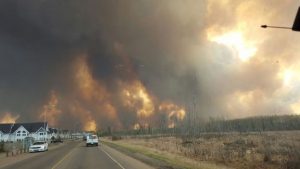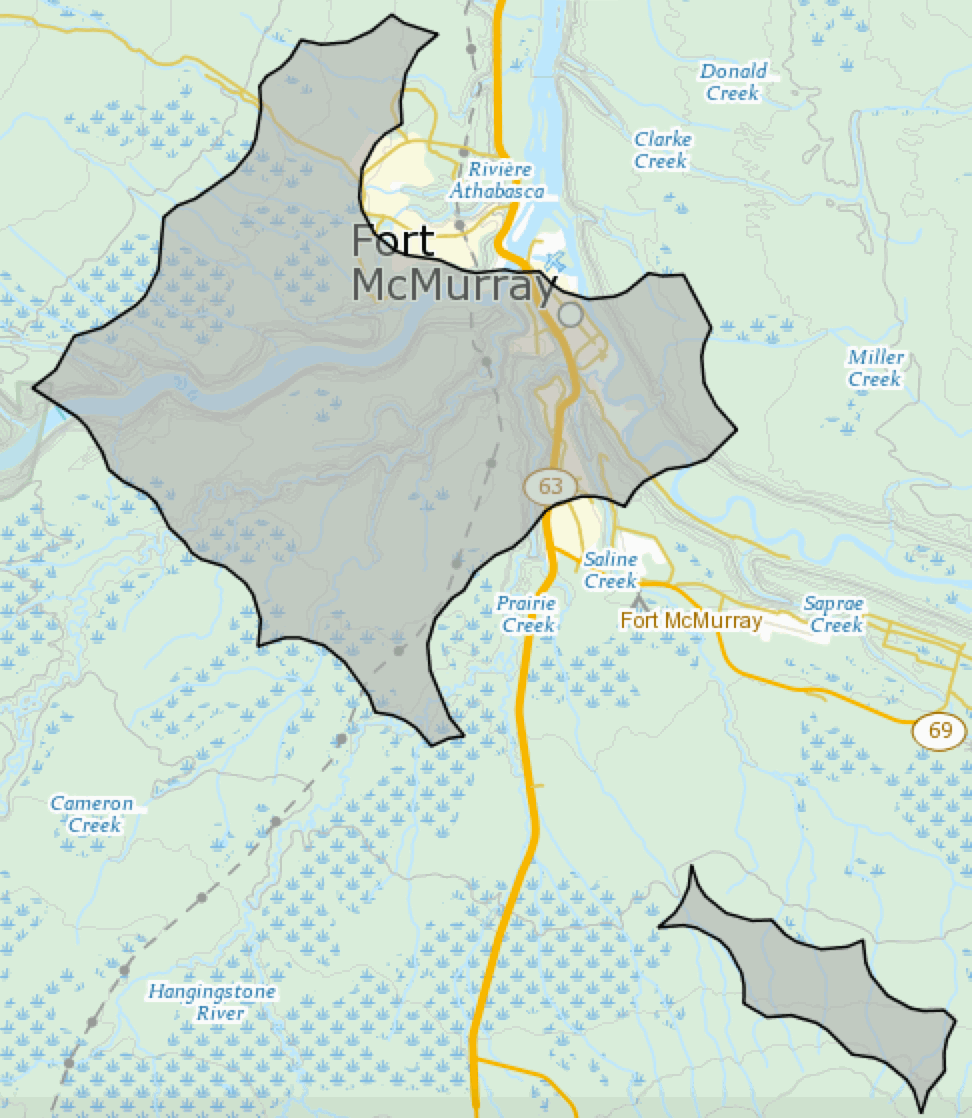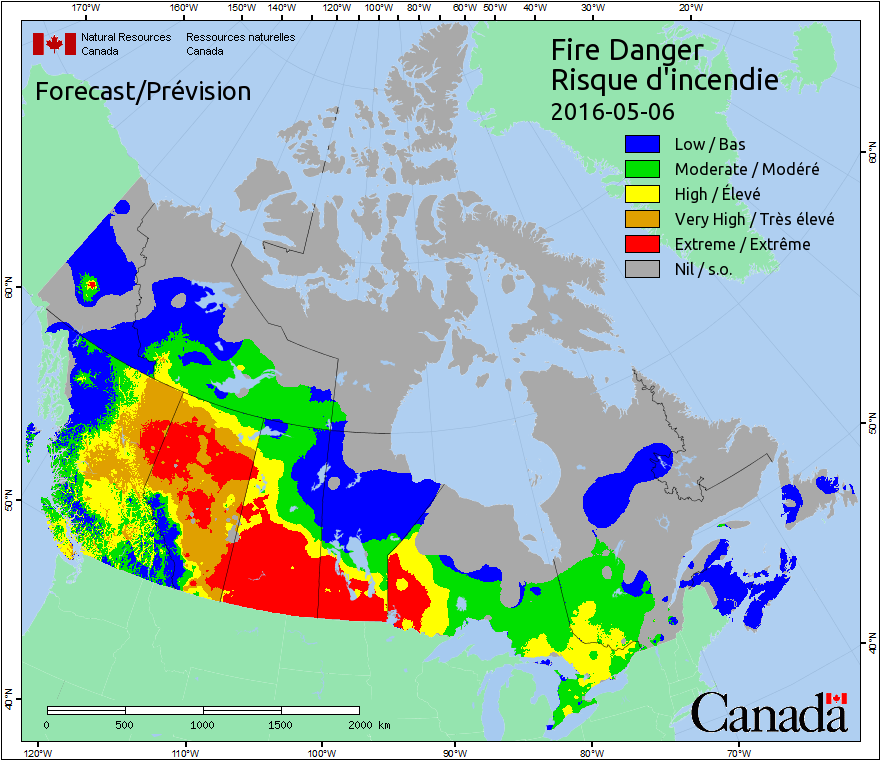The scale of the disaster unfolding in the Fort McMurray region of Alberta, Canada keeps growing, with the fires still raging it has just been reported that BMO Capital Markets, part of the Bank of Montreal, has estimated insurable damage at up to C$9 billion (US$7bn).
 The low-end of the BMO estimate is said to be C$2.9 billion (US$2.26bn). Even at that low-end of the estimated insurance industry loss range the Fort McMurray wildfire disaster would become the largest insured loss event in history for Canada.
The low-end of the BMO estimate is said to be C$2.9 billion (US$2.26bn). Even at that low-end of the estimated insurance industry loss range the Fort McMurray wildfire disaster would become the largest insured loss event in history for Canada.
At the upper end of the scale the wildfire would be the largest insurance loss event of the year globally so far and would without doubt result in a hit to reinsurance markets and also some insurance-linked securities (ILS) funds, and perhaps investors in certain collateralised reinsurance sidecars as well.
The estimate from BMO Capital Markets was given to Canadian news network CBC, who broadcast it in the last hour. The Bank estimated C$9 billion as the insurance cost for the town of Fort McMurray to be completely rebuilt, so it is an edge-case estimate of the maximum upper bounds of the loss and we shouldn’t expect it to crystalise that way.
The analyst from the Bank of Montreal also said that if the damage can be contained to between a quarter and a half of all structures being destroyed in the town, the cost to rebuild would be between $2.6 billion and $4.7 billion.
So this is a loose loss estimate at best, but it does provide some idea of the potential.
Clearly it’s still very early days for estimates of insurance and reinsurance losses from this terrible event to be accurate, so it should be noted that it’s not possible to add any colour or clarification to BMO’s estimate.
But the size of loss that the top-end of the estimate suggests, and the fact that even the lower end would be a record insured loss in Canada, reflects the severity of the wildfire and the almost certainty that this is going to be a very significant event for Canada’s insurance industry and maybe some global insurance and reinsurance markets too.
Latest reports suggest the fire is still causing devastation and destruction, with the wildfire having headed south and the airport and other more commercial areas under increasing threat. The situation does not yet seem to be easing and the toll will continue to rise it seems, increasing the impact on the insurance industry and any exposed reinsurance firms.
There is cooler weather and some rainfall forecast for the next 24 to 48 hours in the region, but at this time and given the ferocity of the blaze around Fort McMurray it’s hard to tell how much of a dampening effect that will have.
The latest (May 5th 2016) Fort McMurray wildfire extent map from Natural Resources Canada can be seen below and shows the fire has spread further since yesterday (click the image for a larger version).
Fire weather forecasts show an extreme situation continuing over the coming days, despite the expecation of some rain and cooler temperatures.
The latest update from risk modeller AIR Worldwide is below.
Massive Wildfire Continues to Rage in Fort McMurray, Alberta: AIR
BOSTON, May 5, 2016 – According to catastrophe modeling firm AIR Worldwide, firefighters are currently struggling to control a massive wildfire that has destroyed more than 1,600 structures in Fort McMurray in Alberta, Canada, and is spreading into forest around the community. The fire began in a mobile home park and spread rapidly, thanks to unseasonably high temperatures, low humidity, and strong winds. No injuries or fatalities have been reported as a direct result of the fire, and a state of emergency has been declared. The fire is still not contained and threatens the remainder of Fort McMurray and the forest around it. AIR anticipates that losses arising from this fire will likely far exceed those arising from the Slave Lake wildfire in 2011 that destroyed 522 homes and structures.
Fort McMurray, the largest community in the Regional Municipality of Wood Buffalo, is located 435 kilometers (270 miles) northeast of Edmonton at the confluence of the Athabasca and Clearwater rivers. It is an isolated community surrounded by boreal forest in the middle of the Athabasca oil sands responsible for it becoming a single industry boomtown at the center of one of Canada’s oil production hubs. Elevated neighborhoods with areas of woodland place much of the community in a Wildland Urban Interface and at high risk from wildfire.
By late day on May 3 more than 80,000 people in and around Fort McMurray had been placed under a mandatory evacuation order. Traffic blocked Highway 63, the only route connecting Fort McMurray to the outside world, and hindered emergency services. As the fire temporarily closed the highway, thousands of evacuees turned back and headed to the north of Fort McMurray where there are few major settlements and no support services to receive them. The local airport and hospital are both closed.
The blaze first moved north and east across Fort McMurray, but on May 4 strong winds turned the fire south, putting three small communities at risk. Anzac, Gregoire Lake Estates, and Fort McMurray First Nation communities about 50km (30 miles) south of the city were accordingly given mandatory evacuation orders.
“With very few exceptions, catastrophic wildfires occur when three conditions are met simultaneously: dry heat maximizes the volatility of vegetation; extreme winds, which can drive the propagation of a fire through that vegetation, occur; and a fire ignites close to a moderately or heavily populated area,” said Dr. Tomas Girnius, principal scientist at AIR Worldwide. “All three conditions obtained in the vicinity of Fort McMurray and, with an estimated 1,600 plus homes destroyed, the wildfire that is now happening there is certainly catastrophic.”
Dr. Girnius continued, “Extreme winds always hinder wildfire firefighting. The already inherent difficulties that extreme winds cause are greatly aggravated when the direction of those winds changes frequently and erratically. Simplifying somewhat, when the wind direction is predictable and constant, firefighters can focus their efforts downwind, where the most rapid expansion of the fire is likely to occur; when the wind changes unpredictably, those suppression efforts must encircle the fire entirely, stretching resources significantly. The Fort McMurray wildfire has been very much aggravated by such strong and erratic winds.”
Fort McMurray sits at a lower elevation than most other parts of Alberta and can be a “hot spot.” Temperatures in the area soared to over 90°F earlier this week but are now down considerably and expected to stay low. Unfortunately, very little precipitation, which would be a great boon for firefighters, is in the forecast. However, winds are expected to diminish, and that should allow firefighters to finally contain and control this calamity.
With the area closed and the fire still far from under control, it is too soon to have an accurate picture of the destruction, but it is clear that there has been a massive loss of property. In the latest official estimates 70% of the houses in the Beacon Hill neighborhood have been lost, in Abasand 50% have been destroyed, Waterways has lost 90%, and Wood Buffalo has lost 30 homes. Because of the oil industry, housing in the area is more expensive than its remoteness would suggest; in 2006 Fort McMurray had the highest real estate prices in Alberta.
The local economy relies on natural gas and oil pipelines, forestry, and tourism, all of which will undoubtedly be impacted by this event. The major oil sands facilities in the area are not currently threatened by the fire, but several of the oil companies active in the area have shut down pipelines so that they could evacuate non-essential personnel. As a result, production has been reduced according to the Austrian consultancy JBC Energy.
Our article from yesterday: Fort McMurray, Canada wildfire could be a significant insurance event.
 View all of our Artemis Live video interviews and subscribe to our podcast.
View all of our Artemis Live video interviews and subscribe to our podcast.
All of our Artemis Live insurance-linked securities (ILS), catastrophe bonds and reinsurance video content and video interviews can be accessed online.
Our Artemis Live podcast can be subscribed to using the typical podcast services providers, including Apple, Google, Spotify and more.

































